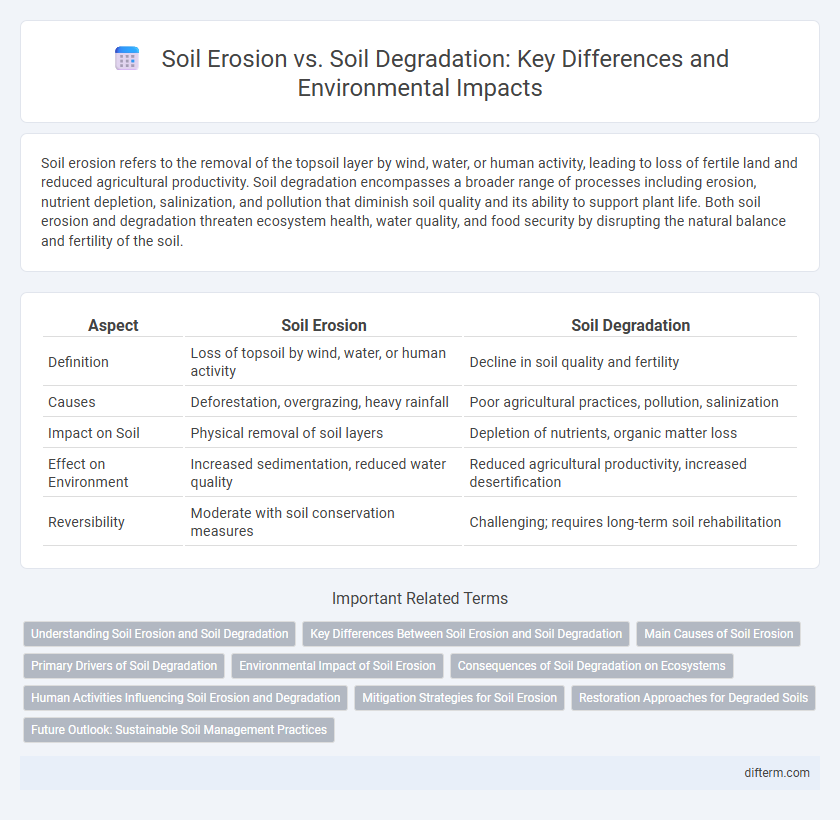Soil erosion refers to the removal of the topsoil layer by wind, water, or human activity, leading to loss of fertile land and reduced agricultural productivity. Soil degradation encompasses a broader range of processes including erosion, nutrient depletion, salinization, and pollution that diminish soil quality and its ability to support plant life. Both soil erosion and degradation threaten ecosystem health, water quality, and food security by disrupting the natural balance and fertility of the soil.
Table of Comparison
| Aspect | Soil Erosion | Soil Degradation |
|---|---|---|
| Definition | Loss of topsoil by wind, water, or human activity | Decline in soil quality and fertility |
| Causes | Deforestation, overgrazing, heavy rainfall | Poor agricultural practices, pollution, salinization |
| Impact on Soil | Physical removal of soil layers | Depletion of nutrients, organic matter loss |
| Effect on Environment | Increased sedimentation, reduced water quality | Reduced agricultural productivity, increased desertification |
| Reversibility | Moderate with soil conservation measures | Challenging; requires long-term soil rehabilitation |
Understanding Soil Erosion and Soil Degradation
Soil erosion refers to the process whereby topsoil is removed by wind, water, or human activity, leading to the loss of fertile land. Soil degradation encompasses a broader range of deteriorating soil functions, including erosion, compaction, nutrient depletion, and contamination, which reduce soil productivity. Understanding the distinctions between soil erosion and soil degradation is essential for developing effective land management and conservation strategies.
Key Differences Between Soil Erosion and Soil Degradation
Soil erosion primarily involves the removal of the topsoil layer by wind, water, or human activity, leading to a loss of fertile land. Soil degradation refers to the decline in soil quality caused by factors such as erosion, chemical contamination, nutrient depletion, and compaction, resulting in reduced productivity and biodiversity. While erosion is a physical process, degradation encompasses a broader range of chemical, physical, and biological changes impacting soil health.
Main Causes of Soil Erosion
Soil erosion primarily results from water runoff, wind, deforestation, and unsustainable agricultural practices that disturb the soil structure. Intense rainfall accelerates surface runoff, washing away the topsoil rich in nutrients essential for plant growth. Human activities such as overgrazing, improper land use, and removal of vegetation cover exacerbate the erosion process, leading to significant loss of fertile land.
Primary Drivers of Soil Degradation
Soil degradation primarily results from factors such as deforestation, overgrazing, and unsustainable agricultural practices that disturb soil structure and reduce fertility. Soil erosion, a key contributor to degradation, is driven by water runoff, wind, and human activities that remove the topsoil layer essential for plant growth. Climate change exacerbates these processes by increasing the frequency of extreme weather events, further accelerating soil quality decline.
Environmental Impact of Soil Erosion
Soil erosion significantly accelerates soil degradation by removing the nutrient-rich topsoil essential for plant growth and water retention. This loss leads to decreased agricultural productivity, increased sedimentation in waterways, and heightened vulnerability to drought and flooding. The environmental impact includes habitat destruction, reduced biodiversity, and intensified carbon release from disturbed soil layers.
Consequences of Soil Degradation on Ecosystems
Soil degradation leads to reduced soil fertility, impairing plant growth and decreasing agricultural productivity, which disrupts food chains and habitats within ecosystems. It causes loss of organic matter and biodiversity, diminishing soil microbial activity essential for nutrient cycling and ecosystem resilience. This degradation exacerbates water runoff and sedimentation, contributing to aquatic ecosystem pollution and loss of biodiversity in nearby water bodies.
Human Activities Influencing Soil Erosion and Degradation
Human activities such as deforestation, overgrazing, and improper agricultural practices significantly accelerate soil erosion by removing protective vegetation cover and disrupting soil structure. Urbanization and construction expose soil to water and wind forces, increasing degradation rates and reducing land fertility. Intensive farming techniques, including repeated tillage and chemical misuse, deplete organic matter, leading to severe soil quality decline and diminished ecosystem functionality.
Mitigation Strategies for Soil Erosion
Mitigation strategies for soil erosion include contour plowing, terracing, and planting cover crops to reduce surface runoff and maintain soil structure. Implementing agroforestry practices and maintaining vegetation buffers along waterways help stabilize soil and prevent sediment loss. These measures enhance soil health, reduce degradation risk, and sustain agricultural productivity over time.
Restoration Approaches for Degraded Soils
Restoration approaches for degraded soils prioritize practices like reforestation, cover cropping, and contour farming to stabilize soil structure and enhance organic matter content. Techniques such as mulching and the application of biochar improve moisture retention and nutrient availability, counteracting the effects of soil erosion and degradation. Implementing sustainable land management, including no-till agriculture and erosion control barriers, mitigates further soil loss while promoting long-term soil health rehabilitation.
Future Outlook: Sustainable Soil Management Practices
Sustainable soil management practices such as agroforestry, cover cropping, and reduced tillage are essential to mitigate soil erosion and combat soil degradation. Innovations in precision agriculture enable targeted interventions that preserve soil structure and fertility, ensuring long-term productivity. Future outlook emphasizes integrated land-use strategies and community-driven conservation efforts to restore degraded soils and enhance ecosystem resilience.
soil erosion vs soil degradation Infographic

 difterm.com
difterm.com